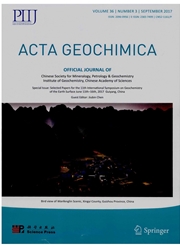

 中文摘要:
中文摘要:
系统的分析无机并且包括碳酸盐岩石和泥石头的 MiddlePermian 源岩的有机地球化学被执行与从 Junggar 的露头和讨厌的人收集的样品,在北 Xinjiang 的 Turpan 和 Ili 盆。Thisstudy 证实为一个古老的水团的沉积参数例如无机地球化学和古盐度,有一种靠近的关系到源岩的有机物。在源岩的 phytane 优势主要由于减少的环境,这也被揭示。Biomarkers 例如 gammacerane 和β - 叶红素,在沉积环境在样品反映特定的咸度。有强壮的减少环境的沉积地区是更可能的生产主要有机物的存款,它将被埋葬并且 preservedcontemporarily。因而,源岩比平常的在器官的内容和更好无机的类型通常高,并且反过来也如此。
 英文摘要:
英文摘要:
A systematic analysis of the inorganic and organic geochemistry of Middle Permian source rocks comprising carbonate rocks and mudstones was carried out, with samples collected from the outcrop and bore of the Junggar, Turpan and Hi basins in northern Xinjiang. This study confirmed that sedimentary parameters for an ancient water body, such as inorganic geochemistry and paleosalinity, have a close relation to the organic matter of source rocks. It is also disclosed that phytane predominance in the source rocks is mainly due to a reducing environment. Biomarkers, such as gammacerane and β-carotene, in the samples reflect a specific salinity in the sedimentary environments. Sedimentary zones with a strong reducing environment are more likely to produce deposits of primary organic matter, which will be buried and preserved contemporarily. Consequently, the source rocks are generally high in organic content and better in organic type than ordinary ones, and vice versa.
 同期刊论文项目
同期刊论文项目
 同项目期刊论文
同项目期刊论文
 期刊信息
期刊信息
